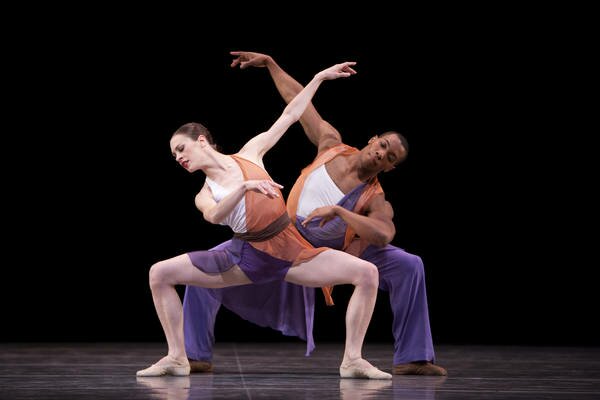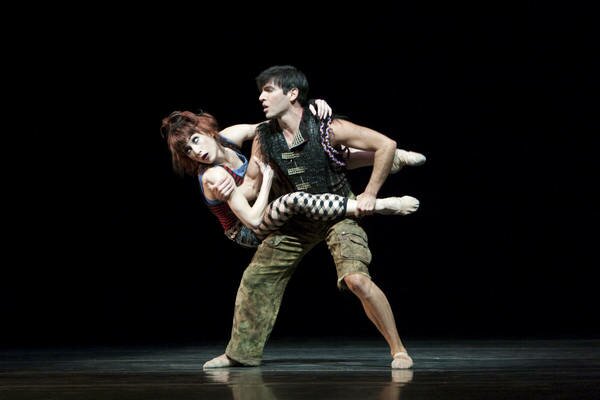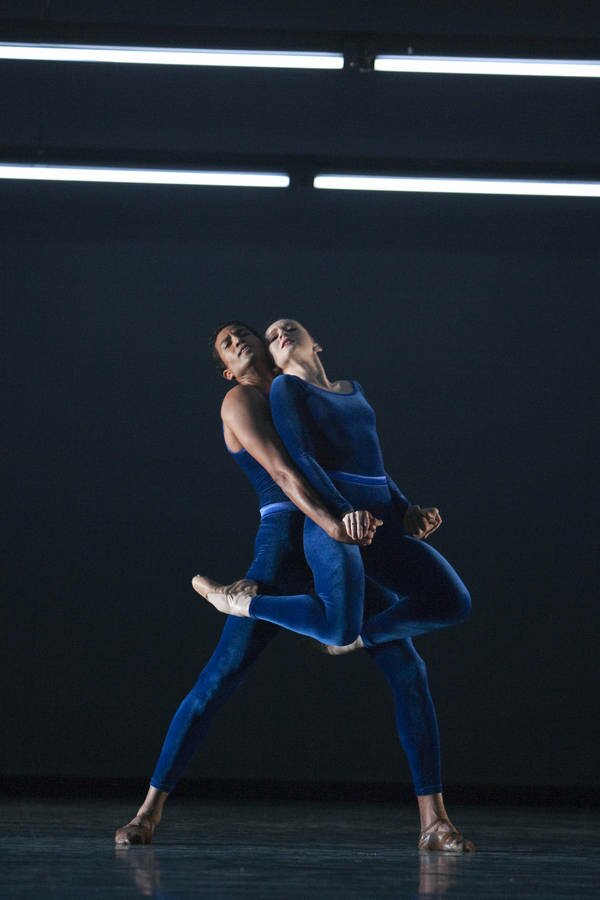An evening with Twyla Tharp is worth making plans for, even if it's a vicarious accompaniment, through the medium of her dance works.
The three pieces on Pacific Northwest Ballet's "All Tharp" program (ends November 14) this time are Opus 111, Afternoon Ball, and Waterbaby Bagatelles, and it feels a bit like dinner date that begins with a walk through an autumn forest declaiming Keats, includes dinner at a dangerously chic nightspot with a window-view of the street, and ends with flipping through candid snaps of an Olympics swim team clowning and flirting in between meets.
Depending on which night you go, there's a special treat for PNB fans, given her impending departure at the end of the season, to see Ariana Lallone in one or more pieces.
 Pacific Northwest Ballet soloist Rachel Foster and corps de ballet dancer Kiyon Gaines in Twyla Tharp’s Opus 111, presented as part of ALL THARP, Nov. 5-14, 2010. Photo © Angela Sterling
Pacific Northwest Ballet soloist Rachel Foster and corps de ballet dancer Kiyon Gaines in Twyla Tharp’s Opus 111, presented as part of ALL THARP, Nov. 5-14, 2010. Photo © Angela Sterling
Brahms' String Quintet underpins Opus 111, and PNB gives you a live quintet (two violins, two violas, and cello) to enjoy. It's four movements, and you see five couples--everyone has their favorites, I'm sure, but for me the kinetic Batkhurel Bold and Carla Körbes stood out, along with a smoldering Ariana Lallone and Karel Cruz--though Tharp's mind seems equally focused on the overall picture: sides of the stage mirror each others' moves, or a movement series ripples its way through a diagonal line. I always wonder how much when you see a dance affects what you see, but something about Mark Zappone's costumes, fluttering swaths of color, made me think of the unpredictable way leaves twirl, coming down. And in any event, the dancers pirouette and spin throughout the piece, their arms almost always in motion, shoulders shrugging or pointing. They're frequently raised in a rounded "V" that near the end, when a more heel-and-toe folk-dance style arrives, becomes that fuller goblet shape you know from Russian dances, a pronouncement of hale-and-heartiness you can't help but be warmed by.
 Pacific Northwest Ballet soloist Chalnessa Eames and principal dancer Jonathan Porretta in Twyla Tharp’s Afternoon Ball, presented as part of ALL THARP, Nov. 5-14, 2010. Photo © Angela Sterling
Pacific Northwest Ballet soloist Chalnessa Eames and principal dancer Jonathan Porretta in Twyla Tharp’s Afternoon Ball, presented as part of ALL THARP, Nov. 5-14, 2010. Photo © Angela Sterling
Afternoon Ball despite using Vladimir Martynov's "Autumn Ball of the Elves" for a score, has a more wintry feel to it; when she was here for the world premiere, Tharp confessed that a paraphrasing of the "The Little Matchstick Girl" had snuck into the work, except here it's a little matchstick boy, and you get the feeling it's not matchsticks he's hustling. Jonathan Porretta and Chalnessa Eames were the on-again, off-again couple last night, the kind who are alternately mad at the world (shake fist at heaven) and at each other. Olivier Wevers is the third wheel; he and Porretta share a brokeness, where Tharp has them separately glide a bit, as if on sidewalk ice, and then fall and clutch their hip. Martynov's music fuses minimalism and post-romanticism--there's a descending figure that plays in different iterations as the the couple fights and clutches at each other, Wevers diffidently trying to break in by taking up their moves--and a lushness as a serenely graceful couple (Lallone and Jeffrey Stanton) sweep in for a pas de deux. They spark an interest in Porretta's character, who watches and imitates, when he's not twitching from withdrawal. Other people have seen redemption in an apparition in white with an extravagance of train who enters on a diagonal, and takes Porretta under her arm, but I always think of her as an Ice Queen.
 Pacific Northwest Ballet principal dancers Karel Cruz and Carla Körbes in Twyla Tharp’s Waterbaby Bagatelles, presented as part of ALL THARP, Nov. 5-14, 2010. Photo © Angela Sterling
Pacific Northwest Ballet principal dancers Karel Cruz and Carla Körbes in Twyla Tharp’s Waterbaby Bagatelles, presented as part of ALL THARP, Nov. 5-14, 2010. Photo © Angela Sterling
Despite the title, there's a genuine grandeur to Waterbaby Bagatelles in that the piece defeats any attempt to make sense of it, but its non sequiturs subtract nothing from its impact. Stringing together Anton Webern's Sehr langsam (an excerpt from Six Bagatelles), Kevin Volans' White Man Sleeps #5, John Lurie's Bella by Barlight, David Lang's The Anvil Chorus, Astor Piazzolla's Fear (from Five Tango Sensations), Mickey Hart's The Hunt, and John Adams's On the Dominant Divide, and featuring a striking series of fluorescent lights that raise and lower to create a ceiling, Tharp's work might remind you of the profusion of life around a reef--you might argue with all the wild colors and shapes, but you would ultimately lose because these things exist. There's an alpha male (Batkhurel Bold, last night) who lays some entrechat on a coterie of giggling bathing beauties (or so the bathing caps argue), some of whom, prone, kick their heels behind them in delight. When he's not preening in front, Bold almost swims through them. Kiyon Gaines appeared to similar "get a load of me" effect. In the scene pictured above, Cruz lifts Körbes, and then she pivots on his hands, as if about to launch herself forward into the water, and you desperately wish you could rewind that again and again. As with Opus 111, but perhaps hidden behind the evident fun, there's a rigorous formalism to the presentation of figures against ensembles, and as ensembles are created by addition and subtraction, as if the stage were a viewfinder, adding dancers or hiding them as you "look" right or left. Tharp persuades you this kind of precision is the essence of a kind of joie de vivre.

 Subscribe to our Front Page Stories
Subscribe to our Front Page Stories
![]() Subscribe to all SunBreak Stories
Subscribe to all SunBreak Stories



Most Recent Comments